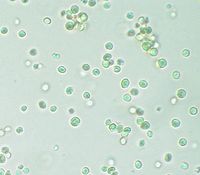
Photo from wikipedia
Aircraft soot has a significant effect on the air quality and human health. The aim of this study is to investigate the evolution of soot morphology in free jet laminar… Click to show full abstract
Aircraft soot has a significant effect on the air quality and human health. The aim of this study is to investigate the evolution of soot morphology in free jet laminar diffusion flames between Chinese traditional aviation kerosene RP-3 and algae-based aviation biofuels. The differences in height, profile, and structural properties of soot between the RP-3 flame and biofuel flame are determined. A laboratory-made probe sampling method was applied for soot sample collection. Transmission electron microscopy (TEM), high-resolution transmission electron microscopy (HRTEM), X-ray diffraction (XRD), and elemental analyzers were used to analyze the collected soot particles. The average particle size of soot increases first and then decreases in both flames, and the size of biofuel primary particles is smaller than that of jet fuel RP-3 particles along the same flame height. At the flame tip, the primary particle sizes of RP-3 soot and biofuel soot are 22.7 and 15.6 mm, respectively. In comparison with the RP-3 soot, the nanostructure of biofuel soot particles along the same flame height exhibits a shorter fringe lattice, a larger fringe tortuosity, and a larger interlayer spacing, which indicate a higher degree of oxidation reactivity. Meanwhile, RP-3 soot particles have a lower H/C atom ratio and have greater intensity in X-ray diffraction, which indicates a more orderly and compact lattice structure. This study provides some references in studying the algae-based biofuel with regard to soot formation.
Journal Title: ACS Omega
Year Published: 2022
Link to full text (if available)
Share on Social Media: Sign Up to like & get
recommendations!